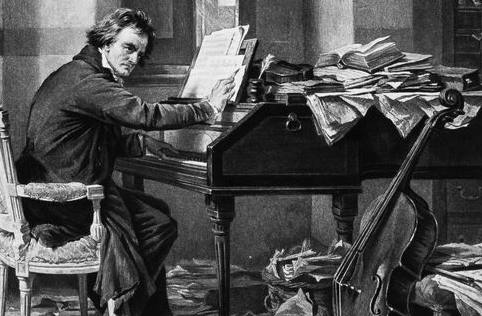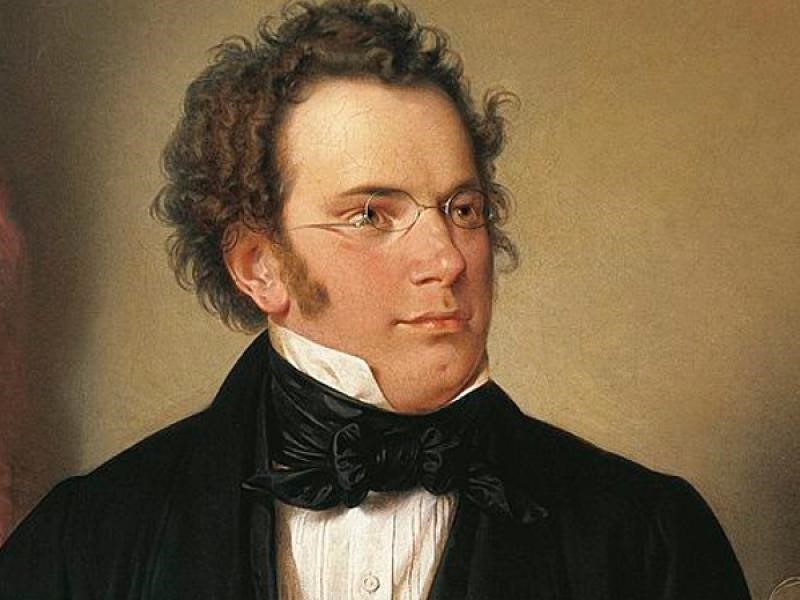1797-1828
Il poeta dalla sensibilità umbratile e allusiva,
che attraverso la forza della melodia
fa risuonare il centro dell’ anima.
Figlio di un maestro di scuola, dodicesimo di diciannove fratelli, passò l’infanzia in condizioni economiche estremamente precarie ma in una famiglia di spiccate attitudini musicali, infatti ben presto suonerà la viola con il padre e due fratelli. Incomincia a studiar musica con il maestro del coro e a undici anni è cantore del convitto reale a Vienna, dove può proseguire gli studi avendo tra gli insegnanti il Salieri.
La sua attitudine al canto lo porterà successivamente ad esprimere i sentimenti più profondi con i lieder, canti con testi di poeti del tempo e sarà la sua peculiarità, suonare e cantare tra amici anche con pochi intimi, melodie incantevoli, capaci di accompagnare l’anima verso un silenzio dorato.
In Schubert il flusso del canto è il fulcro del suo impeto lirico, in cui l’ascoltatore accoglie i flutti di una ricchezza sonora che pervade ogni cellula del discorso musicale.

Schubert scriveva i suoi lieder da giovanissima età, incoraggiato da amici fu convinto di fare visita a Beethoven, in quel tempo di chiara fama e nel pieno della sua maturità, infatti andò in una sera fredda di neve, bussò, Beethoven tardò ad aprire, busso più forte e ad alta voce infastidito tuonò Beethoven, Schubert si spaventò, lasciò alcune sue composizioni per terra dietro la porta, piccoli Lieder (canti) con accompagnamento al pianoforte , e scappò scivolando sulla neve raggiungendo i sui amici dietro l’angolo per dileguarsi per le strade viennesi. Beethoven raccolse e mise sul suo piano quei fogli che rimasero per molto tempo, raccontano gli amici nelle biografie, e il compositore esperto non si espresse su quella musica finchè un giorno disse : “Quel giovanotto è una scintilla divina”.

La musica del giovane compositore esprime un diretto avvicinamento alla condizione umana, la penetra intimamente, si identifica con essa vivendo così un senso di solitudine che trova consolazione, appagamento e trasfigurazione nel canto dell’anima.
Una generazione separa i due musicisti, Schubert morì un anno dopo la morte di Beethoven all’età di 31 anni e a differenza del famoso Beethoven che con sforzi eroici termina le sue sinfonie nella luce e nella vittoria sulle tenebre, il giovane compositore Viennese ripiega su se stesso trasfigurando la sua malinconia in bellezza e accettazione della fragile condizione umana.
Il pensiero artistico del compositore è simile a quello di Leopardi: la lucidità di abbracciare il dolore, un dolore cosmico. Questo non significa ciglio aggrottato, perpetuo lamento, ma contrappone al sentimento di consapevolezza della fragilità e transitorietà umana, la dolcezza, la tenerezza e la bellezza della vita che sono tali perché danno anche se per un solo momento il giubilo del cuore.
Ecco quindi che alle forze di urto del pensiero Beethoveniano, Schubert preferisce la giustapposizione di momenti musicali, di melodie che amano disporsi su piani armonici diversi nel loro mutarsi e vivere la loro trasfigurazione nelle tonalità lontane, non posando mai, fino alla serenità dell’accettazione della condizione umana.
L’intuizione artistica del compositore è la consapevolezza acuta del senso di impermanenza di quello che noi percepiamo come realtà, il musicista non sa dove porta il suo peregrinare, ma accetta attraverso la metamorfosi del sentimento lo svanire di tutto quello che per noi è certezza; quello che a fine secolo attraverso Nietzsche diverrà Il Troppo umano” E la “Distruzione delle certezze”.
La contemplazione musicale è riferita piu che alla morte in se all’archetipo della”Fine delle cose”alla trasformazione dei rapporti umani, degli affetti piu profondi, al doloroso distacco da cio che ci sta piu a cuore, e al senso di impotenza che ne scaturisce.
Tutto questo è sintetizzato nel Lied dal titolo “la morte e la fanciulla”, dove la fanciulla è l’allegoria dell’anima umana e la morte l’archetipo della fugacità di ciò che per noi è certezza. Questo celebre Lied fu composto nel febbraio 1817,annuncia l’approssimarsi di un cambiamento. Un breve recitativo drammatico tratteggia la resistenza della fanciulla e si placa nella rassegnazione. Due volte essa ripete «non toccarmi» con decisione affievolita. La morte riprende la danza e conduce la fanciulla con sé. Essa non è crudele e la fanciulla riposerà nelle sue braccia. Da notare la penetrazione del sentimento espressa in musica unica nel suo genere, per il quale Beethoven diceva “questo giovane è una scintilla divina”
Guida all’Ascolto
Il brano è per pianoforte e voce, Schubert percorre il cammino della trasfigurazione con grande conoscenza del sentimento umano, strutturandolo in 3 parti.
- Consapevolezza di un cambiamento, della fine di un percorso, di un affetto, di una certezza.
- Reazione, grido e lotta dell’anima umana, sentimento di impotenza.
- Accettazione dolorosa, lasciarsi andare a ciò che non conosciamo, con dolcezza e bellezza, dove il contrappunto della Speranza abbraccia l’anima con armonie luminose.
Comincia il piano in cui le armonie descrivono un sentimento di triste rassegnazione, una consapevolezza dolorosa punge il nostro sentimento ; La fanciulla “(l’anima ), risponde lottando, vivendo la disperazione, la non accettazione, e dopo il primo non mi toccare arriva la trasfigurazione verso un’ altra consapevolezza con il secondo “NON MI TOCCARE”, questa frase musicale racchiude il pensiero Schubertiano.
La risposta della morte è rappresenta da nota fissa presa integralmente dal Don Giovanni nella scena del cimitero in cui parla il Commendatore dall’aldila, una citazione completa.
Dopo la metamorfosi parla una nuova realtà che accoglie con dolcezza il sentimento spaurito e smarrito, con un abbraccio di speranza e di rinnovamento ignoto per l’essere umano, ma aperto alla Fede che anima Beethoven Mozart e i precedenti.
https://www.youtube.com/watch?v=DgvM0g4fGBE
Su questo link si puo vedere e ascoltare una prova in casa di due interpreti di Schubert, e poi seguire con il testo di Matthias Claudius (1740- 1814).
| LA MORTE E LA FANCIULLA | |
|
Das Mädchen: Vorüber, ach, vorüber! Geh, wilder Knochenmann! Ich bin noch jung, geh, Lieber! Und rühre mich nicht an. Und rühre mich nicht an. |
La fanciulla: Via, ah, sparisci! Vattene, barbaro scheletro! Io sono ancora giovane; va’, caro! E non mi toccare. Non mi toccare |
|
Der Tod: Gib deine Hand, du schön und zart Gebild! Bin Freund und komme nicht zu strafen. Sei guten Muts! Ich bin nicht wild, Sollst sanft in meinen Armen schlafen! |
La morte: Dammi la tua mano, bella creatura delicata! Sono un’amica, non vengo per punirti. Su, coraggio! Non sono cattiva, dolcemente dormirai fra le mie braccia! |
Con questo tema Schubert ha composto il secondo tempo del quartetto per archi D810 , un ‘andante per con 5 variazioni sul tema, da cui prende il titolo tutta l’opera “La morte e la fanciulla”. IL brano viene eseguito solo strumentalmente come approfondimento ed espressione dei contenuti del Lied per
canto e piano. Il finale dell’ultima variazione sul tema termina nella luce armonica risonante di umile accettazione, creando nell’ascoltatore grande pace e serenità, e soprattutto saggezza nel viaggio della vita.
Si può ascoltare sul link qui sotto questa composizione.
https://www.youtube.com/watch?v=_rB7-JYMrWE
Discografia
| Compositore Schubert, Franz <1797-1828> | |||||||
| Der Tod und das Mädchen (D 531) Collocazione I&S 516 Class | |||||||
| 2.5: Streichquartette : D 353 (no. 11), D 810 (no. 14) Schubert, Franz <1797-1828> | |||||||
| Inventario | A V 2967 | ||||||
| Collocazione | I&S 175 Class 5 | ||||||
A cura di Marco Maria Lacasella
Franz Schubert and feeling’s harmonies
The poet of the aloof and allusive sensibility,
who through the power of melody
echoes with the soul’s middle.
Son of a school teacher, the twelfth of nineteen siblings, he spent his childhood in extremely poor economic conditions but in a family with excellent aptitudes for music, so much so that he soon played the viola with his father and two brothers. He started to play music with the chorus’ teacher and, at the age of 11, he became cantor of Vienna’s royal boarding school, where he could continue to study having Salieri among his teachers.
Later, his aptitude for singing led him to express the deepest sentiments through the Lieder, chants with texts of some poets of his time, and his peculiarity was that of playing and singing among friends, even with few intimates, lovely melodies capable of accompanying soul towards a golden silence.
In Schubert, the flow of singing is the fulcrum of his lyrical impetus, in which the listener receives the waves of a sonorous richness that pervades every cell of the musical discourse.
Schubert wrote his Lieder at a very young age. Encouraged by friends he was convinced to call on Beethoven, at that time with a great reputation and at the peak of his maturity. In fact, he called on him during a cold snowy evening, he knocked on the door but Beethoven was slow to open, so he knocked harder. A bothered Beethoven shouted loudly – Schubert was frightened, left some of his compositions on the floor behind the door, some small Lieder (chants) with piano accompaniment, and ran away sliding on the snow, reaching his friends around the corner to disappear throughout the streets of Vienna. Beethoven picked up and put on his piano those sheets that remained there for a long time. Friends tell this in biographies, and the expert composer did not express himself on that music until one day he said: “That young man is a divine spark”.
The music of the young composer expresses a direct approach to the human condition, it intimately penetrates it, identifying with it, thus experiencing a sense of solitude that finds consolation, satisfaction and transfiguration in the soul’s song.
A generation separates the two musicians, since Schubert died a year after Beethoven’s death at the age of 31 and – unlike the famous Beethoven, who with heroic efforts ends his symphonies in light and in victory over darkness – the young Viennese composer isolates himself transfiguring his melancholy into beauty and acceptance of the fragile human condition.
The composer’s artistic thought is similar to Leopardi’s one: the lucidity of embracing pain, a cosmic pain. This does not mean a frown, perpetual lament, but it contrasts the feeling of awareness of the human fragility and transience with the sweetness, tenderness and beauty of life which are such because they give the heart’s rejoicing, even if for a single moment.
Hence, instead of the impact forces of Beethoven’s mindset, Schubert prefers the juxtaposition of musical moments, of melodies that love to be arranged on harmonic levels – that are different in their mutation – and live their transfiguration in distant tonalities, never stopping until the serenity of acceptance of the human condition.
The composer’s artistic intuition is the acute awareness of the sense of impermanence of what we perceive as reality, the musician does not know where his wanderings lead, but accepts, through the metamorphosis of feeling, the disappearance of all that is certainty for us, that at the end of the century through Nietzsche became “All Too Human” and the “Destruction of certainties”.
Musical contemplation refers more than to death itself to the archetype of the “End of things” to the transformation of human relationships, of the deepest affections, to the painful separation from what is most important to us, and to the sense of helplessness that springs up.
All this is summarized in the Lied entitled “Death and The Maiden”, where the maiden is the allegory of the human soul, and death is the archetype of the fleetingness of what is certainty for us. This famous Lied was composed in February 1817, and it announces the approach of a change. A short dramatic recitative outlines the girl’s resistance and calms down in resignation. Twice she repeats “don’t touch me” with a weakened determination. Death resumes the dance and takes the girl with it. She is not cruel and the girl will rest in her arms. Note the penetration of sentiment expressed in music that is unique of its kind, for which Beethoven said “this young man is a divine spark”.
Listening guide
The piece is suitable for piano and voice. Schubert walks the path of the transfiguration with a great knowledge of human sentiment, structuring it in 3 parts.
- Awareness of a change, of the end of a journey, of an affection, of a certainty.
- Reaction, cry and struggle of the human soul, a feeling of helplessness.
- Painful acceptance, let ourselves go towards what we do not know, with sweetness and beauty, where the counterpoint of Hope embraces the soul with bright harmonies.
The level begins in which the harmonies describe a feeling of sad resignation, a painful awareness wounds our sentiment; the girl “(the soul)” responds by struggling, experiencing distress, no-acceptance, and after the first do not touch me, the transfiguration towards another awareness arrives with the second “DO NOT TOUCH ME”; this musical phrase contains the Schubert’s mindset.
The answer of death is represented by a fixed note entirely taken by Don Giovanni in the cemetery scene in which the Commendatore speaks from the afterlife, a complete quotation.
After the metamorphosis, a new reality speaks and gently welcomes the frightened and lost sentiment, with an embrace of hope and renewal unknown to the human being, but open to the Faith that animates Beethoven, Mozart and the previous ones.
https://www.youtube.com/watch?v=DgvM0g4fGBE
Through this link you can see and hear an in-house rehearsal of two Schubert performers, and then you can follow with the lyrics by Matthias Claudius (1740-1814).
Traduzione a cura di Gabriele Azzarone Tirocinante del Corso di studi in Lingue moderne per la comunicazione e la cooperazione internazionale, Università degli Studi di Macerata.




